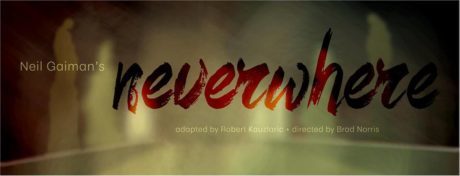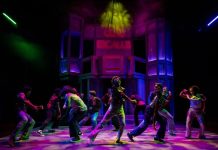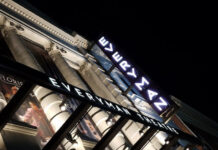In Part Eight of a series of interviews with cast members of Cohesion Theatre Company’s Neverwhere, meet Director Brad Norris.
Patricia: Please introduce yourself and tell our readers about some of the many hats you’ve worn in the Baltimore theatre community.

Brad: Norris. Brad Norris. My name is Brad Norris. I’m bad at constructing thoughts into sentences. I’m the director of Neverwhere, as well as a Co-Founder and Artistic Producer with Cohesion Theatre Company. I hail from Indianapolis, and spent about 10 years doing theatre and dance in Chicago before moving to Baltimore back in 2009. In addition to directing, designing and building with Cohesion, I directed Edward II at Spotlighters, which birthed the idea for Cohesion. Prior and simultaneous to that, I worked as the Events Manager at Center Stage. I was a company member and Artistic Director with the Jewish Theatre Workshop for several years, where I directed and acted in several productions. Later this summer, I’ll also be teaching a week-long stage combat workshop for young adults with Baltimore Shakespeare Factory. I’m also actively working with several other members of the theatre community on reigniting an organization of area theatres similar to the old Baltimore Theatre Alliance. Hats. I wear hats.
What made you select Neverwhere as one of the shows Cohesion would tackle this year?
Lots of discussions and debates. It mostly came down to finding a show that I wanted to direct that would push us and be exciting for the company, while also appealing to new audiences. We broke a lot of new ground this season, and tackled a lot of big issues, and examined what theatre could be and do. We wanted something that would challenge us, but also be a fun ride for people who came along. Neverwhere has been one of my favorite novels for years, and this adaptation was done by Lifeline Theatre in Chicago, which is a group that I really respect and admire (big shout out to Chris and Mandy Walsh whom I love from so much distance). So when I reached out to get a copy of it, I was blown away with how it moved and the way it took this story and crammed it all into something we could actually accomplish on stage. From there it was mostly about convincing ourselves that we could do it. Whatever “it” was. Everyone who heard we were doing it was super excited, so that enthusiasm throughout the season really helped us to feel like we had made a good choice, but it also put a lot of pressure on us to deliver.
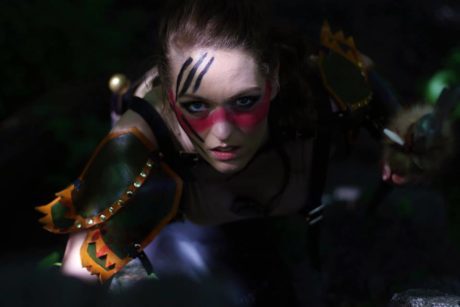
I mean this respectfully, particularly as you guys did a truly fantastic job on the show, but what on Earth were you thinking?! It’s only Cohesion’s second season in existence; you’re a small company and you undertook an enormous show.
Yeah, that’s totally fair. We asked ourselves that question so many times. From the beginning of this company though, we have tried to live in and foster a creative environment that doesn’t allow for anyone saying something can’t be done. Our official company motto is “setting unrealistic goals, and then meeting them.” That has been born out of our very first achievements, and we’ve seen it play out over and over again. We still don’t believe our hype or spend much time patting ourselves on the back. There’s always more work to do, and success just emboldens us to try more. With Neverwhere I have to give full credit to the commitment and dedication of the cast and creative team who jumped in for the one of the longest and most creative production process I’ve ever been a part of. We just took it one idea at a time. One piece at a time. We begged and borrowed and built and got a new theatre space. Then we built the world one bloody brick at a time. I still see it that way a bit, so it’s hard for me to view the whole, or to see what the audience sees when they come. I’ll be sad when it’s over, but I am so very proud of what we achieved. And now we’ll be able to look back at this show when we come up against future obstacles and say “remember when we did Neverwhere? This is nothing compared to that.”
In your Director’s Note for this production, you shared your great appreciation and admiration for Playwright Neil Gaiman. Do you feel like Cohesion has done Neverwhere justice? Do you think Gaiman would approve?
I thought about that a lot during the process. I wanted him to come see this and also was terrified of what he’d say if he did. I think there’s a huge challenge in taking something you’ve loved in your head for so long and trying to put it on stage. You have to be open to collaboration and new and different ideas from all sides, while still keeping your vision on track. In many ways, this show is not the Neverwhere I see in my mind when I read the book anymore. I’m sure it’s not the Neverwhere that each cast or crew member saw either. But I think everyone borrowed and adapted, and did their very best to stay true to the characters and locations and ideas so much that what happens on stage has become what Neverwhere is now to so many new audiences. And they’ve loved it. So in a way, I think what justice we’ve done is to pass the story along. To present it for the first time to people in just as gripping and exciting a way as Gaiman does. We are now a part of what Neverwhere is to others, and that (pardon my language) is really fucking cool. I think Neil would approve of that.
What were some of the challenges you faced in making Neverwhere a reality?
Oh, so many. I mean, this was the biggest and most expensive production we’ve ever put on. We had budgets we’ve never had. We did things we had no business doing. And we were testing the limits of a space that was basically brand new to us. We designed and constructed massive moving set pieces out of steel. We installed grid work for our lighting equipment. We had an electrician come and rewire the space for more power (and when they did it wrong the first time we had them come back to fix it). We installed a full floor in the space to play on. So much. And that’s all just some of the technical things. There were costumes for over 30 characters, props and set locations for dozens of spaces. We built a two-person wearable beast of London. And the cast lived with these characters for the better part of the last 6 months as we did book clubs and table work. Honestly if I sit down and think about all the things we accomplished and all the things we made happen that shouldn’t have worked, and that other people might have said we couldn’t do, then I’ll be writing a novel as long as Neverwhere before I’m done. It was a lot. I am proud of every person who helped for what they did and their boldness in tackling this.
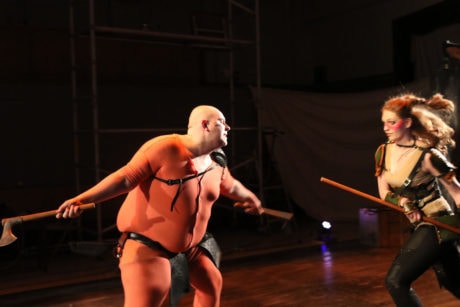
You seemed to use every inch of the theater in Neverwhere. How did the physical attributes of your new performance space contribute to (or hinder) your ability to stage the show how you envisioned it?
I don’t even remember how I thought about this show before this space. I think we always knew we wanted to have levels, but the moving set pieces were really made possible by this space and room we had to work in. It was always important to me to put the audience right in the middle of the action, so that fed into the layout of the space. Once we had that, we didn’t have an inch to waste. We were really fortunate that we found the space we did with the height it had and the ability to create a floor space of our own that spanned the room. And I have to say that the folks at United Evangelical Church really trusted us and gave us so much freedom to make the space what we wanted it to be. In order to visualize the massive moves and the many locations we had to go to, I actually took Kel’s set drawings and built them out of Lego so that we could have them in the rehearsal room with us and I could show the cast what we would be doing from the very beginning. The movement of the show became such an important element, so it helped so much to see all the moves in small scale for weeks before having to actually move the boxes.
Part of Cohesion’s mission is creative collaboration between companies. How does this principle influence your approach to directing? Were there ideas that cast members presented that you were able to integrate into the production?
The first thing I stress to the cast at the beginning of the rehearsal process is that the best idea in the room is the best idea in the room. I’m not god, I’m just the one trying to create a collaborative environment, so I very much encourage discussion and creativity. Especially on a project like this, there’s no way I can create the lives of all these characters on my own. This is an ensemble piece where the actors really have to take responsibility for their characters and the way they present them on stage. I’m there to guide them and let them know what is and isn’t working, and I have a big idea in my head, but I always think an actor works better when they feel connected to something they have created, and an idea they were responsible for. The Floating Markets are almost entirely the creation and improvisation of this cast shining through. I really love the energy they generate from the audience every night. That being said, there’s no moment on stage that doesn’t have something that the cast thought of. Probably the one I smile at the most though is when Bobby Henneberg as Mr. Vandemar finishes eating his rat, and then proceeds to take out his tools in an attempt to perform some “tutelary dentistry” on Richard Mayhew. It was a brilliant moment of comedy, and it was Bobby all the way.
What have you enjoyed most about this experience since beginning rehearsals?
The commitment of everyone involved. No one said “no.” Ever. Casey Dutt had never picked up a quarterstaff, or done any stage combat really before this show, and she just smiled, put on her determined face and got to work. Now she’s the baddest ass in Baltimore. Joseph Coracle injured his neck in the weeks leading up to opening, but he kept climbing ladders and getting kicked and hit and choked until he felt better and we kept going. People overcame their doubts and fears and just did, over and over again. And now this show is a beast that works. That made me so very amazed and made me want to work a 100% at every moment of every day.
Are there specific moments from this process that you know you’re going to cherish and remember for a long time? Can you share any of them?
Yes. There are so many I’ll treasure when I sit down to remember all the things we did. Working with Stage Manager Heather Lynn Peacock every day. Seeing my good friend Jon Rubin create so much wonderful violence for this show. Watching Haley Horton paint (seriously I could just watch that girl paint for hours, she makes such beautiful things). Visiting Lewis Shaw for weapons with Bobby Henneberg and having Lewis talk to us about Neverwhere, because he knows it all inside and out, then him letting us use that amazing crossbow of his. But mostly I spent so much time with our TD, Lana Riggins putting this show together. She kept me organized and kept me fed when I couldn’t do it myself. Lana and I went to the Canton Ace Hardware for something almost every day, and I loved those trips. If you haven’t been to the Canton Ace, I can’t recommend it enough. Seriously just go and marvel at their collection of sodas. One day though, Lana and I had to go visit DS Pipe and Supply to get our grid pipe re-cut and threaded, and it was glorious. We both just fell in love with that huge warehouse full of steel and pipe. I can’t really explain it. It sounds weird, but it was a moment you had to be there for, and only Lana and I were.
What has impressed you most about your cast?
Their dedication and drive to do amazing work. I think the thing that makes me smile the most after the show is when someone comes up to me to say they loved it and then they say “and this cast… wow.” That’s how I felt every day of rehearsals. We lost power in the building one night and we did at least another hour of a combat rehearsal by cell phone flashlight. These folks don’t quit, and they don’t settle for their second best. If you are a producer or director and you’re looking for a great actor to work with, you couldn’t go wrong with anyone in this cast. But I get first dibs.
In addition to performing one or more roles, the cast was responsible for moving those giant boxes – often with several people aboard – back and forth across the stage. How did they keep their energy level and precision so steady for 3 hours? Was backstage stocked with Power Bars and Gatorade?
You know I was surprised the first night I didn’t watch the show and stayed backstage at what a zen-like environment it was. With all the changes and things, you’d think it would be only slightly organized chaos from one moment to the next, but these folks just know exactly what they need to do and do it. It doesn’t matter if it’s the fifth costume or makeup change this act, or the seventh reorientation of a 1000+ pound rolling steel box, they do it all with precision, and then they go knock your socks off with the characters they’ve created. At the end of each night everyone is tired and drenched in sweat, but really this show generates its own sort of super human energy, to the point where you go home and are up for a few hours just still buzzing from it all. For Industry Night on Tuesday, we did introduce Klondike Bars into the back stage environment. Ice cream and pie win every time.
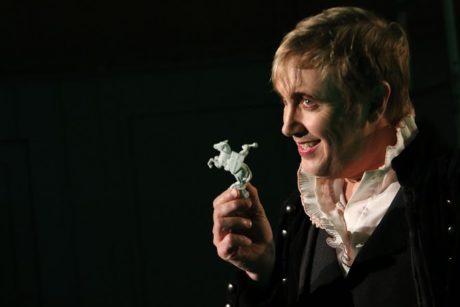
How does the work of your designers help to tell the story and bring your vision to the stage?
It goes without saying that the design team on this production was outstanding. If not for their foolhardy energy in tackling this massive production, we wouldn’t have been halfway to where we are now. I think that just like reading a book, everyone sees a character or location differently in their mind, but some things are constant and iconic. It was the work of the designers to bring that same sense of iconic images to the stage while also leaving space for the audience’s own imagination to help create some of the elements. In that sense, things like Costumes and Props had very specific tasks and in some cases very specific descriptions from the novel to draw from to make their work as fully-realized as possible.
On the other end of the spectrum, with sets and lights, we needed to suggest locations rather than fully create them. And I love how the combination of the real and suggested elements puts the focus on the characters and their realities, while still leaving the audience a sense of wonder and suspension of disbelief. I was also pretty pleased that a lot of the work I did as sound designer got to happen late in the process so I saw how so many elements were working together already and I could just come in with sounds to add a little final touch to a moment or environment. The whole process was really special, and each of these designers are so very imaginative and willing to go to places that are scary and dangerous.
In addition to directing Neverwhere, you were also the Sound Designer. Why did you decide to take on that role instead of bringing someone in to handle it?
Well, I didn’t want it at first. I tried to get two other people on board, but both fell through, one after the other. After that, I knew I could achieve what I wanted, and we were running low on time to bring a new designer on board, so I took it on. It was a welcome break, actually, when I finally got to sit down and craft a soundscape for the show. At that point, the actors were in such a good place and the rest of the elements had come together so wonderfully that I felt a little useless, so it was like getting to craft something again at the end of the process. I don’t recommend it, but I was happy with the way it turned out.
Why do you think audiences should come see the show?
I really don’t know. I could say something self-important about the piece and what a gargantuan feat we’ve accomplished, and what the piece says about being human. But really I think it’s just a fun ride for an audience member to take. It’s not going to solve the world’s problems or anything, but at least for one final weekend, I can’t think of a better way to spend three hours than this. I will miss it when it’s gone, and I don’t want anyone else to miss their chance to see it.
What’s next for you? Do you get a rest or are you right back to planning for Cohesion’s third season?
Season three planning took a break for a while, so yes, that’s the first priority. I’m looking forward to getting a little bit of sleep, then teaching for Baltimore Shakespeare Factory this summer. And then I’m taking a real break. I won’t be directing next season for Cohesion, mostly because I want to give other directors a chance to work with us. I could also stand the time off to do something new theatrically. So, I’m writing a new work that is actually going to be quite epic in scope. This is the first public forum I’ve explained this in, so EXCLUSIVE! I’m creating a five-part play series called The Iron Race Pentology. The first installment is called The Golden Race, and I’ve set myself a deadline of Fall 2017 for its public reveal. So I’ve got about a year and a half-ish. It’s an original work that’s not based on any existing story, but it does weave in a lot of real historical elements. I won’t say more than that about it right now though. So that’s what’s coming for me.
—
BIO: Brad Norris (Director, Sound Design) is a Co-Founding Artistic Producer of Cohesion and holds a B.A. in Theatre from Columbia College Chicago. He is a member and Advanced Actor Combatant of the Society of American Fight Directors. Brad’s most recent work includes performing and Fight Choreographing Ham-let with Cohesion, The Complete Deaths of William Shakespeare with Baltimore Shakespeare Factory and Cohesion, Directing Men on Boats and Feathers and Teeth as part of ParityFest Baltimore 2015, and Directing Cohesion’s production of 13 Dead Husbands. He is an avid fan of pie, board games, and you for supporting the arts. He loves his wife and two children very much, and is looking forward to seeing them again once Neverwhere is done. Brad currently has no projects lined up for 2016/17. Wanna hire him?
Neverwhere plays through June 19, 2016 at Cohesion Theatre, performing at United Evangelical Church – 3200 Dillon Street, in Baltimore, MD. Tickets can be purchased at the door or online.
LINKS:
Review of Neverwhere on DCMetroTheaterArts by Patricia Mitchell.
Interviews from London Below: Inside Cohesion Theatre’s ‘Neverwhere’: Part 1: Joseph Coracle.
Interviews from London Below: Inside Cohesion Theatre’s ‘Neverwhere’: Part 2: Cori Dioquino.
Interviews from London Below: Inside Cohesion Theatre’s ‘Neverwhere’: Part 3: Jonas David Grey.
Interviews from London Below: Inside Cohesion Theatre’s ‘Neverwhere’: Part 4: Matthew Lindsay Payne.
Interviews from London Below: Inside Cohesion Theatre’s ‘Neverwhere’: Part 5: Bobby Henneberg.
Interviews from London Below: Inside Cohesion Theatre’s ‘Neverwhere’: Part 6: Cassandra Dutt.
Interviews from London Below: Inside Cohesion Theatre’s ‘Neverwhere’: Part 7: Melanie Glickman.
Interviews from London Below: Inside Cohesion Theatre’s ‘Neverwhere’: Part 8 – Director Brad Norris.


